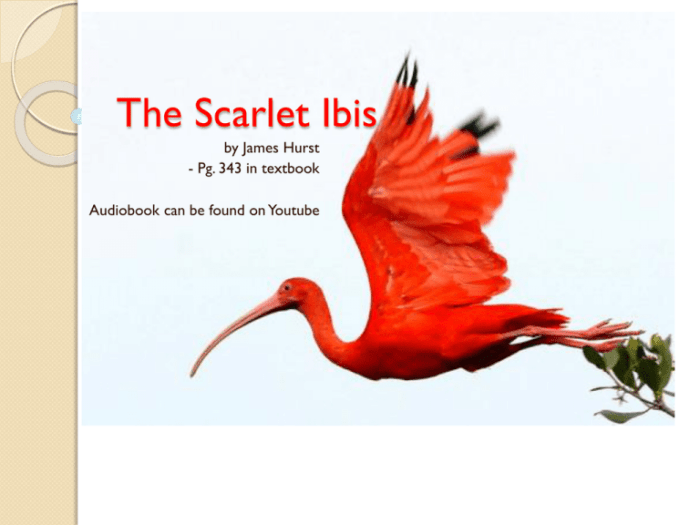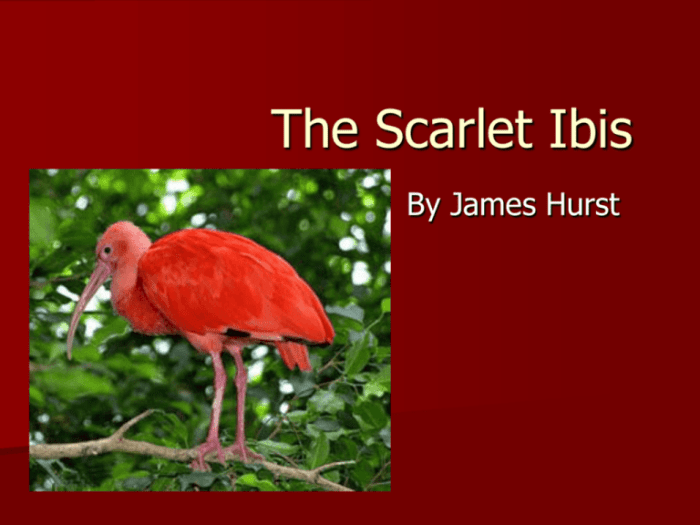The Scarlet Ibis Full Text invites readers to delve into a captivating tale that explores the profound themes of nature, death, and family. This literary masterpiece, crafted with exquisite prose and vivid imagery, unravels a poignant narrative that will resonate deeply within the hearts and minds of all who encounter it.
As we journey through the pages of this timeless work, we will encounter a cast of unforgettable characters, each grappling with their own unique struggles and desires. The setting, a remote and unforgiving landscape, serves as a backdrop for a story that transcends time and place, speaking to the universal human experience.
The Setting

The story of “The Scarlet Ibis” is set in the rural South of the United States in the early 1900s. The specific location is not mentioned, but the story’s descriptions of the setting evoke a sense of isolation and poverty.
The time period is significant because it was a time of great social and economic change in the South. The Civil War had recently ended, and the region was struggling to rebuild. The story’s characters are affected by the poverty and social inequality that were prevalent during this time.
The Social Context, The scarlet ibis full text
The social context of the story is also important. The characters live in a small, isolated community where everyone knows everyone else. There is a strong sense of community, but there is also a lot of prejudice and superstition. The story’s characters are judged by their appearance and their social status.
The Characters

The Scarlet Ibisfeatures a cast of unforgettable characters who drive the story’s themes and conflicts. These characters are vividly portrayed, their motivations and complexities adding depth and resonance to the narrative.
Immerse yourself in the captivating tale of “The Scarlet Ibis” by James Hurst. As you delve into the poignant narrative, consider the transformative power of empathy and compassion. For a deeper understanding of the importance of corporate social responsibility, explore the Swot Analysis For Toms Shoes . This insightful article highlights the company’s innovative approach to combining profitability with positive social impact.
Return to the pages of “The Scarlet Ibis” with a renewed appreciation for the enduring lessons it imparts about human connection and the fragility of life.
At the heart of the story are two brothers, Doodle and the narrator. Doodle is a physically disabled child who struggles to keep up with his older brother, while the narrator is a proud and determined boy who is both protective and resentful of his younger sibling.
Doodle
- Doodle, born with severe physical disabilities, is a gentle and loving child. Despite his limitations, he is determined to prove his worth and gain the acceptance of his brother.
- His resilience and determination inspire the narrator to overcome his own challenges, teaching him the value of compassion and the importance of embracing differences.
- The symbolism of Doodle’s name, “Doodle,” reflects his childlike nature and the way he is perceived by others as a mere “scribble” or afterthought.
The Narrator
- The unnamed narrator is a complex and flawed character. He is initially ashamed of Doodle and struggles to accept his brother’s disabilities.
- As the story progresses, he undergoes a transformation, learning to love and appreciate Doodle for who he is.
- His journey of self-discovery and redemption highlights the power of love and the transformative nature of relationships.
The Plot
The Scarlet Ibis tells the story of a young boy named Doodle, who is born with a severe physical disability, and his older brother, the narrator. The story follows the brothers’ relationship as they navigate the challenges of Doodle’s disability and the narrator’s own feelings of inadequacy.The
plot of The Scarlet Ibis can be divided into four parts:
Rising Action
The rising action begins with the birth of Doodle and the narrator’s initial reaction to his brother’s disability. The narrator is ashamed of Doodle and tries to hide him from the world. However, as Doodle grows older, the narrator begins to accept him and even becomes protective of him.
The rising action culminates in the narrator’s decision to teach Doodle to walk.
Climax
The climax of the story occurs when the narrator and Doodle are caught in a thunderstorm. The narrator is afraid to leave Doodle behind, but he also knows that he cannot carry him to safety. In a moment of desperation, the narrator leaves Doodle alone and runs for help.
Falling Action
The falling action begins when the narrator returns to find Doodle dead. The narrator is devastated by his brother’s death and realizes that he has lost the one person who truly loved him. The falling action ends with the narrator’s reflection on his relationship with Doodle and his own mortality.
Resolution
The resolution of the story occurs when the narrator comes to terms with Doodle’s death and his own feelings of guilt. The narrator realizes that Doodle was a gift from God and that he should have cherished him more. The story ends with the narrator’s hope that he will one day see Doodle again in heaven.The
plot structure of The Scarlet Ibis creates suspense and tension by gradually building up to the climax. The reader is constantly wondering what will happen to Doodle and the narrator, and the suspense reaches its peak during the thunderstorm scene.
The falling action and resolution provide a sense of closure and allow the reader to reflect on the story’s themes.
The Themes
The Scarlet Ibis explores several profound themes that intertwine throughout the narrative. These include the complexities of nature, the inevitability of death, and the intricate bonds of family.
Nature
The natural world serves as a central motif in the story, reflecting the characters’ inner struggles and the harsh realities of life. The vibrant, unforgiving landscape of the Louisiana bayous mirrors the challenges faced by Doodle and his brother. The scarlet ibis, a symbol of both beauty and fragility, represents Doodle’s vulnerability and the fleeting nature of life.
Death
The story is permeated by the presence of death, which casts a somber shadow over the narrative. Doodle’s physical frailty and ultimate demise serve as a poignant reminder of the inevitability of mortality. The scarlet ibis, with its crimson plumage, foreshadows Doodle’s impending death and symbolizes the transience of life.
Family
The bond between Doodle and his brother is a complex and multifaceted one. Despite their differences, the narrator grapples with feelings of love, protectiveness, and resentment towards his sibling. The story explores the challenges and rewards of familial relationships, highlighting the enduring power of love in the face of adversity.
The Style

James Hurst employs a lyrical and evocative writing style that immerses readers in the vibrant and often harsh natural world of the Southern marshes. His use of vivid imagery, rich symbolism, and evocative figurative language creates a multisensory experience that enhances the emotional impact of the story.
Imagery
Hurst’s descriptions of the setting are rich in sensory detail, evoking the sights, sounds, smells, and textures of the marshes. For example, he describes the ibis as “a crimson streak that flashed across the sun” and the swamp as “a vast, dim world of tangled vines and swollen streams.”
Symbolism
The scarlet ibis is a powerful symbol throughout the story. It represents both the exotic and dangerous aspects of nature, as well as the fragility and beauty of life. The bird’s death symbolizes the tragic loss of innocence and the harsh realities of life.
Figurative Language
Hurst employs a variety of figurative language techniques, including metaphors, similes, and personification. For example, he describes the ibis’s feathers as “like the petals of a rose” and the swamp as “a brooding presence.”
Unique Literary Techniques
Hurst’s use of foreshadowing and irony adds depth and complexity to the story. The foreshadowing of the ibis’s death creates a sense of impending doom, while the irony of the boy’s desire to protect the bird highlights the futility of his efforts.
The Cultural and Historical Context
James Hurst’s “The Scarlet Ibis” was written in 1960, during a time of great social and cultural change in the United States. The story reflects the values and beliefs of the time period, including the importance of family, the struggle for acceptance, and the search for identity.
Changing Social Norms
In the 1960s, the United States was experiencing a period of rapid social change. The civil rights movement was gaining momentum, and the traditional roles of men and women were being challenged. These changes are reflected in the story, which features a family that is struggling to adapt to the changing social norms.
The Importance of Family
In the 1960s, the family was still seen as the cornerstone of society. “The Scarlet Ibis” reflects this value by portraying a family that is close-knit and supportive. However, the story also shows that families can be imperfect, and that even the strongest families can be torn apart by tragedy.
The Struggle for Acceptance
The 1960s was a time when many people were struggling to find their place in society. This struggle is reflected in the story, which features a young boy who is trying to find his place in his family and in the world.
The Search for Identity
The 1960s was also a time when many people were searching for their own identity. This search is reflected in the story, which features a young boy who is trying to find out who he is and what he wants to be.
Reception Over Time
“The Scarlet Ibis” has been interpreted and received by different audiences in different ways over time. When it was first published, the story was praised for its realism and its insights into the human condition. However, in recent years, the story has been criticized for its portrayal of disability and for its lack of diversity.
Comparison to Other Works

James Hurst’s “The Scarlet Ibis” shares several similarities and distinctions with other classic works of American literature, such as F. Scott Fitzgerald’s “The Great Gatsby” and J.D. Salinger’s “The Catcher in the Rye.”
Themes
All three works explore themes of isolation, disillusionment, and the pursuit of an unattainable dream. In “The Scarlet Ibis,” Doodle’s physical limitations and social isolation mirror Gatsby’s failed pursuit of Daisy and Holden Caulfield’s alienation from society.
Style
Hurst, Fitzgerald, and Salinger employ vivid and evocative prose to create distinct literary worlds. Hurst’s use of sensory imagery and symbolism, Fitzgerald’s lyrical and poetic language, and Salinger’s colloquial and introspective style contribute to the immersive experiences of their respective narratives.
Characters
Doodle, Gatsby, and Holden are all complex and flawed characters who struggle with their own inner demons. Doodle’s physical fragility and vulnerability contrast with Gatsby’s larger-than-life ambition, while Holden’s cynical and disillusioned perspective differs from both Doodle’s innocence and Gatsby’s optimism.
Unique Aspects of “The Scarlet Ibis”
Despite its similarities to other works, “The Scarlet Ibis” stands out as a unique and significant work of literature due to its poignant portrayal of the human condition. Hurst’s exploration of the themes of love, sacrifice, and the fragility of life creates a deeply moving and unforgettable experience for readers.
User Queries: The Scarlet Ibis Full Text
What is the main theme of The Scarlet Ibis?
The main themes of The Scarlet Ibis are nature, death, and family.
Who is the protagonist of The Scarlet Ibis?
The protagonist of The Scarlet Ibis is Doodle, a disabled boy who is determined to overcome his physical limitations.
What is the significance of the scarlet ibis?
The scarlet ibis is a symbol of beauty, fragility, and mortality.
